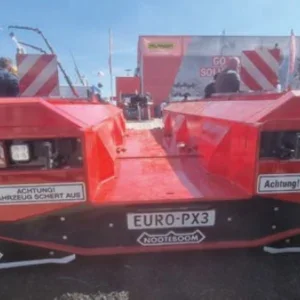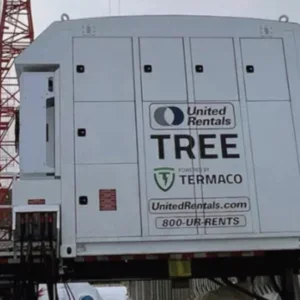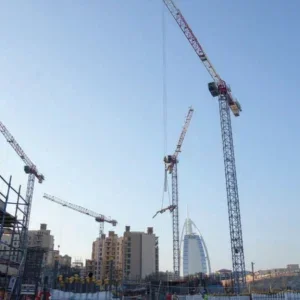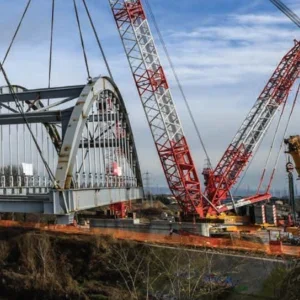For a decade now, Chinese truck cranes have outsold the ‘traditional’ manufacturers by ratios of 5:1, 10:1, or more in the world’s emerging markets.
Thousands of truck cranes, crawler cranes and tower cranes have been shipped from China to India, Brazil, Kenya, Egypt, Indonesia and Azerbaijan. Even markets like Russia, bred largely on indigenous products have taken a serious liking to Chinese cranes, as have some more advanced markets such as South Africa.
‘Official’ statistics don’t tell the complete story of Chinese crane exports. Just as when the Japanese broke into international markets back in the 1970s, indigenous trading companies play a significant role flying under the radar, purchasing cranes domestically for sale internationally.
In 2003, China’s production of truck cranes exceeded 10,000 units for the first time, reaching 10,019. At this time export activity was in its infancy with just 276 truck cranes (2.75% of total production) sold to overseas customers.
By 2006 Chinese truck crane production had increased by 40% to 14,193 but exports had more than doubled their share, with 900 units (6.3%) sold overseas.
As 2007 truck crane production reached almost 20,000 units, exports exceeded 3,200 units (16.3%), rising dramatically to over 5,000 units valued in excess of RMB 8.3 billion ($1.25bn) in 2008.
While the markets of South East Asia, India and Australia were the primary export targets for the Chinese, European dealers and rental companies such as Van Adrighem and Sarens quickly recognized the opportunity afforded by their low prices. Between 2006 and 2008 several significant orders were placed, with Sarens especially finding work for the Chinese cranes on projects in emerging markets.
The initial efforts of the Chinese manufacturers and traders to sell these cranes for use in so called ‘developed markets’ didn’t exactly set the world on fire. Some entrepreneurial dealers saw the small-sized Chinese truck cranes filling the void created when years earlier the popular Kato and Tadano cranes exited the European market. Some even extolled that “China is the new Japan.”
That proved to be a naïve assumption. In markets where truck cranes were the primary focus – as was the case in Australia – things didn’t end so happily. After a fast start, the initial significant successes of Melbourne-based Australian Crane & Manufacturing (ACM) back-fired for the distributor, who ended up reinvesting initial profits as they went to quite extraordinary and highly-costly lengths to correct endemic quality and reliability issues.
These early ‘hiccups’ came as something of a relief for some of the traditional manufacturers. As is ‘the way’ of such things, stories passed by word-of-mouth from salesman-to- salesman, and salesman-to-customer, with issues growing ever-larger.
Even so, with some justification, the established players viewed the product quality and service support of their new competitors as below par for mature markets. Often, they tended to dismiss the vast majority of Chinese cranes as somewhat irrelevant to mainstream demand in their markets. And from one point of view, their stance was justifiable.
Most established manufacturers had discontinued the production of small two- and three-axle truck cranes of up to 30t capacity due to lack of domestic demand. However, these ‘small’ truck cranes—especially 25–30t—lay at the very heart of the Chinese industry, just as they had a generation earlier during what might now be seen as a similar growth phase of demand in Japan, Europe and America.
While established manufacturers recognised the product limitations of the new Chinese market entrants, what they didn’t take seriously enough was the appeal that the much lower-priced Chinese cranes had to the numerous emerging markets around the world that had never been able to afford new cranes and had to settle on a slim diet of very old, damaged, secondhand cranes.
The appeal of a brand-spanking new ‘affordable’ crane was powerful. The contrast between their 20–40-year-old crane fleet and the shining new Chinese cranes with their modern features, very long booms and competitive load charts was a stark one.
Demand cycles
The effect of the global financial crisis on the international crane market was severe, with Chinese truck crane exports declining by 65% to approximately 1,800 units in 2009, valued at just RMB 2.75bn. International market demand for all cranes and construction machinery remained low in 2010.
Despite the lower number of international sales, the Chinese crane industry flourished during this period due to unprecedented levels of domestic demand. In response to the financial crisis the Chinese government announced a $586bn economic stimulus aimed at further domestic residential construction, rural infrastructure, transportation.
The stimulus package served to raise optimism among Chinese manufacturers that the boom in demand would continue and maintain investment in the expansion of production capacity.
Domestic sales of all types of construction machinery reached new highs, with truck crane sales exceeding 27,000 units in 2009 and reaching 34–35,000 units in 2010–11.
2011 was a pivotal year for the Chinese crane industry. International market confidence started to restore and almost 2,000 units of locally produced truck cranes were sent to emerging markets.
On the other hand, the Chinese government made massive cuts to railway projects and slowed residential construction. Zoomlion chairman Zhan Chunxin was amongst the first to sound the alarm with his November announcement that “demand for construction machinery has shrunk dramatically and growth will no doubt continue to slow next year.”
Few in the construction business would have seen this as the start of a five-year steep decline that has caused domestic Chinese truck crane demand to slide to under 8,500 units in 2015.
Not only was that a return to 2002-3 levels, but with massive excess production capacity, huge levels of inventory and repossessions, domestic market conditions have been vicious. Deep price-cutting and extended payment conditions have become the norm.
However, for the past decade, driven by government policies, Chinese manufacturers have been eagerly seeking overseas sales. The main driver has been the earning of foreign funds and building a global presence. A key element in this plan has been the financial backing of the Chinese government.
In the past decade over $550bn has been invested by China in purchasing offshore assets. Many of the Chinese government loans and investments have been directed towards energy-resource rich nations, particularly in Africa and Latin America.
Compared to their ‘Western equivalents’, most of these Chinese loans have been relatively ‘no-strings attached’ and despite dealing with sometimes less-stable government regimes, the Chinese have maintained a policy of staying out of the domestic affairs of their debtor nations.
In the years 2006 to 2015, approximately 23,000 new Chinese truck cranes have been sold to export markets. Virtually none of these have been sold in West Europe, North America and Japan, making this a staggering total.
Many customers had recognized issues of quality and product support, and many had come to terms with them. Crane buyers in most emerging markets were used to ‘going it alone’, generally not being able to afford original manufacturers parts. And frankly, with demand for ‘new’ cranes very low in most emerging markets, local distributor service support was hardly world-class.
Buyers in these markets were well acquainted with operating and repairing very-old cranes, so quality and reliability issues were not such a big deal as in mature markets. Product developments and Improvements
Anyone considering a Chinese crane on the basis of what they saw as recently as five-years ago will need to look again. With the internationalization of industry being a key plank of Chinese government policy, leading manufacturers have become regulars at Bauma, ConExpo and Intermat, displaying those cranes most appealing to overseas markets.
At the same time the Chinese manufacturers have become famous for “emulating” the latest developments in all terrains, crawler cranes and tower cranes with products that sometimes look disturbingly-similar to those of the originators. Truth be told, although more stark, there is nothing particularly new in such an approach and indeed it is a reflection of the worthy goal of the Chinese to seek to match the traditional market leaders in terms of technology and quality.
Even the most fierce sceptics can no longer be disdainful of the impressive pace of product development of the leading Chinese crane makers. With their huge engineering resources the breadth and extent of Chinese crane development has, for some years, matched or exceeded that of the leading manufacturers. It’s also a fact that such ‘subtleties’ are generally lost on many customers— especially when the price is right.
Specifically, on the truck crane front, all of the leading players— XCMG, Zoomlion and Sany—have significantly improved and extended their offering in recent years. These manufacturers offer a plethora of models to suit the needs of numerous different markets. A variety of boom systems and componentry is offered in most capacity classes.
All of the latest cranes now feature folded oval-shaped pin-locked booms and bi-fold jibs that typically offer lengths competitive with those of US, Japanese, and European truck cranes and European all terrains of similar sizes.
Most of the larger capacity models feature the option of imported componentry including engines, transmissions and some hydraulics— even though for cost-sensitive markets—Chinese componentry versions are still available.
Being truck cranes, and considering that most are sold to markets with less-than-perfect product support infrastructure, hydraulically and electronically the machines are designed to a simpler brief than is the case for European all terrains.
Hydraulic functioning and crane control is much improved but still not challenging the very best. Counterweight flexibility and variety is a relatively new arrival to the Chinese industry and market but is now being seen on larger cranes.
Therefore, optimization of load charts due to high counter weighting has not yet been reached.
Generally, beyond the smaller units, axle loads are higher – typically 12.5-to-13t on the rear – in compliance with domestic Chinese allowances. Typically, vehicle dimensions are not a problem from a regulatory point-of-view, even though, the crane vehicles are longer than equivalent-sized ATs.
Safety-oriented design features have come a long way in recent years with improvements in the areas of guard rails as well as a full complement of safety devices and gauges. Product finish and aesthetics leave little to be desired. Bauma China 2016 again saw a wide array of new cranes, if not the ever-larger and sometimes weird concepts of earlier shows.
Domestic market leader XCMG has now extended its XCA all terrain crane line as well as its sister-XCT truck crane that now covers capacity classes from 8t to 220t. While the technology of XCMG’s all terrain cranes continues to move ever closer to the best that Europe can offer, their truck cranes walk the line between advancing technology and the simplicity demanded by emerging markets.
The latest XCT 55 8×4 55t model is the first in its class to feature a six-section boom while the 100t XCT 100 is another good example of the ‘balancing act’ between technology and relative simplicity. The 100t is a 3m wide, five-axle 10x6x6 truck crane with all round leaf-spring suspension and with rear steer to tighten turning radii. It’s a two-engine crane with a choice of Volvo and Chinese Cummins 174kW diesels driving variable displacement piston pumps in the upper. Axles 2, 3 and 4 are driven via a ZF transfer case by a Chinese Cummins 318kW diesel with a US Allison automatic transmission.
Innovatively the front outrigger beam is a swing-out to provide a ‘K-shaped’ base with widths of 5.2m or 7.9m fully-extended. In terms of reach, the XCT 100 is very competitive with a long six-section 13.1–61m folded oval boom with single-cylinder telescoping and pin-locking topped by a 10.6–18.1m offsetable bi-fold lattice.
Unusually for Chinese truck cranes, there’s a wide range of counterweight configurations from 0 to 36t giving very impressive load chart performance. Standard features include fuel-saving technology, electronic joystick controls and central lubrication.
While roadable in most emerging markets, the 13t loads carried on the twin-tyred axles 3 and 4 will limit sales in some markets.
Arch-rival Zoomlion has also been very busy with its new ZMC and ZTC series truck cranes and ZTF series truck-mounted cranes.
The ZTF’s have been displayed at the past two Bauma Munich shows, first on Mercedes-Benz trucks and most recently on MAZ trucks as a product of the firm’s new cooperative manufacturing initiative in Belarus. Like all of Zoomlion’s cranes these new models sport the manufacturer’s new aurora green, gravel grey and cosmic cobalt gray paint scheme.
One of the major themes of the latest Zoomlion products is energy-saving and environment friendliness. With what Zoomlion dubs its ‘intellectualized’ truck crane, the 25t 6×4 ZTC 250 is the first of the manufacturer’s ‘Product 4.0 Project’. Featuring a five-section 42m full-power oval boom – the longest boom in its class – the ZTC 250 has energy saving technology that enables automatic and semi-automatic control of the throttle which, the manufacturer claims, saves an average of 8% fuel and as much as 20% over other truck cranes.
Also at Bauma China was the new 80t ZTC 800V equipped with a 49m five-section oval boom and three-section lattice swingaway. The boom telescope system features Zoomlion’s second-generation free extension technology stabilizing the boom during telescoping. In addition to a variable counterweight system, what appears to be a very useful feature is its low-gear mode for hoist, swing, luffing and telescoping facilitated by a proportional speed regulating valve.
With experienced crane operators at a premium worldwide and crane accidents still far ‘too commonplace’, this system allows the load-sensing swing system to afford speeds as slow as 0.1 degrees/second as well as allowing hoist speeds down to a minimum of 2.5m/minute. The intelligent multipower energy saving system of the ZTC 800V reduces fuel consumption to 4.5l/hr with the added benefit of noise reduction to CE standards.
While attention at the Sany stand at Bauma may have been focused on its new 100t SAC 1000 all terrain and 120t SRC 1200 rough terrain, these new cranes will do very well if they outsell Sany’s 80t capacity truck crane – the STC 800S. Although XCMG and Zoomlion have overall leadership in the domestic Chinese truck crane market, Sany’s 75t and 80t truck cranes have become market leaders in several important export markets including India.
Aesthetically, for some years now, Sany’s truck cranes have set the standard. The new 80t is a solid performer that its manufacturer sees as an attractive alternative to its very successful 75t STC 750. Equipped with a 47m five-section full-power oval boom and 17.5m bi-fold swingaway jib is a well balanced conventional machine.
With an on-board counterweight of just 6.5t, all-up working weight is 46t – but like other larger-sized Chinese truck cranes – the rear axle loads of the STC 800S tip the scales at 12.5t each. Its 8×4 carrier is just 2.75m wide and employs two-stage outriggers extending to 7.8m width to support strong wide radius capacities. The outriggers are electronically controlled and offer automatic leveling. It’s a single engine crane with multi-mode power output and load-sensing variable displacement piston pump. Main and auxiliary hoists are standard and all main crane functions are controlled via electronic joysticks. Sany’s truck crane line extends from 16 to 220t capacity.






